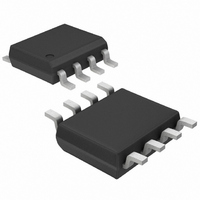DS1722S+T&R Maxim Integrated Products, DS1722S+T&R Datasheet - Page 6

DS1722S+T&R
Manufacturer Part Number
DS1722S+T&R
Description
IC THERMOMETER DIG 3-WIRE 8-SOIC
Manufacturer
Maxim Integrated Products
Datasheet
1.DS1722STR.pdf
(14 pages)
Specifications of DS1722S+T&R
Function
Thermometer, Thermostat
Topology
ADC, Register Bank
Sensor Type
Internal
Sensing Temperature
-55°C ~ 120°C
Output Type
SPI™
Output Alarm
No
Output Fan
No
Voltage - Supply
2.65 V ~ 5.5 V
Operating Temperature
-55°C ~ 120°C
Mounting Type
Surface Mount
Package / Case
8-SOIC (3.9mm Width)
Full Temp Accuracy
+/- 3 C
Digital Output - Bus Interface
Serial (3-Wire, SPI)
Digital Output - Number Of Bits
12 bit
Maximum Operating Temperature
+ 125 C
Minimum Operating Temperature
- 55 C
Lead Free Status / RoHS Status
Lead free / RoHS Compliant
Other names
DS1722S+TR
CONFIGURATION/STATUS REGISTER Figure 2
1SHOT = One-shot temperature conversion bit.
conversions are not taking place), a "1" written to the 1SHOT bit will cause the DS1722 to perform one
temperature conversion and store the results in the temperature register at addresses 01h (LSB) and 02h
(MSB). The bit will clear itself to "0" upon completion of the temperature conversion. The user has
read/write access to the 1SHOT bit, although writes to this bit will be ignored if the SD bit is a "0",
(continuous conversion mode). The power-up default of the one-shot bit is "0".
R0, R1, R2 = Thermometer resolution bits.
thermometer, based on the settings of these 3 bits. There is a direct tradeoff between resolution and
conversion time, as depicted in the AC Electrical Characteristics. The user has read/write access to the
R2, R1 and R0 bits and the power-up default state is R2="0", R1="0", and R0="1" (9-bit conversions).
THERMOMETER RESOLUTION CONFIGURATION Table 5
x=Don’t care.
SD = Shutdown bit. If SD is "0", the DS1722 will continuously perform temperature conversions and
store the last completed result in the temperature register. If SD is changed to a "1", the conversion in
progress will be completed and stored and then the device will revert to a low-power shutdown mode.
The communication port remains active. The user has read/write access to the SD bit and the power-up
default is "1" (shutdown mode).
SERIAL INTERFACE
The DS1722 offers the flexibility to choose between two serial interface modes. The DS1722 can
communicate with the SPI interface or with a standard 3-wire interface. The interface method used is
determined by the SERMODE pin. When this pin is connected to V
When this pin is connected to ground, standard 3-wire communication is selected.
SERIAL PERIPHERAL INTERFACE (SPI)
The serial peripheral interface (SPI) is a synchronous bus for address and data transfer. The SPI mode of
serial communication is selected by tying the SERMODE pin to V
The four pins are the SDO (Serial Data Out), SDI (Serial Data In), CE (Chip Enable), and SCLK (Serial
Clock). The DS1722 is the slave device in an SPI application, with the microcontroller being the master.
The SDI and SDO pins are the serial data input and output pins for the DS1722, respectively. The CE
input is used to initiate and terminate a data transfer. The SCLK pin is used to synchronize data
movement between the master (microcontroller) and the slave (DS1722) devices.
The shift clock (SCLK), which is generated by the microcontroller, is active only when CE is high and
during address and data transfer to any device on the SPI bus.
programmable in some microcontrollers. The DS1722 offers an important feature in that the level of the
MSb
R2
0
0
0
0
1
1
R1
0
0
1
1
x
R0
0
1
0
1
x
1
Thermometer Resolution
1
10-bit
11-bit
12-bit
8-bit
9-bit
1SHOT
Table 5 below defines the resolution of the digital
6 of 14
If the SD bit is "1", (continuous temperature
R2
DDD
DDD
R1
. Four pins are used for the SPI.
Max Conversion Time
The inactive clock polarity is
SPI communication is selected.
0.075s
0.15s
0.3s
0.6s
1.2s
R0
SD
LSb














